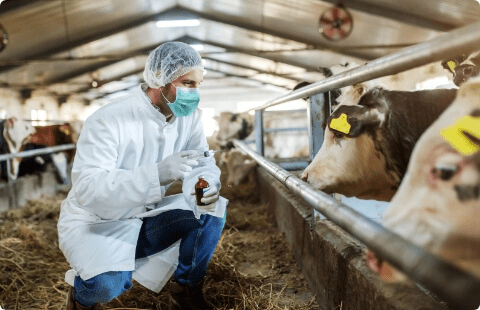Animal production including livestock production can be improved by increase in animal number (herd size) and increase output per unit animal. In order to achieve this improvement, prevention and treatment of diseases must be complementary to other measures like adequate nutrition and good management practices.
Prevention in this sense simply means avoidance of disease and control refers to reduction in disease incidence or prevalence. Eradication refers to complete removal of a disease from an area.
Hygiene is actually preventive medicine and therefore used to prevent diseases. The number of animals that develop a disease within a particular time frame is known as incidence of the disease and this is a measure of the rate of spread.
Prevalence of a disease refers to the number of animals that develop a disease at a specific time and this indicates how serious and how long the disease affects the population of animals. A disease that is constantly present in a population is said to be endemic.
The general methods used for control of livestock diseases are usually aimed at prevention of disease occurrence, control of a disease that is already in existence and eradication of the disease from an area.
The particular method applied in each circumstance is tailored to achieve a specific objective.
Methods for Prevention
The two major methods used for prevention of livestock diseases is aimed stopping a disease from getting to a herd, flock or group of animals. These methods are quarantine and vaccination.
1. Quarantine
This is physical separation of healthy animals from sick or new animals. Also, movements of items are restricted between the two groups of animals.
All new animals to be added to a farm, flock or herd should be quarantined, tested and/or treated appropriately before introduction into the farm or herd. Where very strict quarantine is practiced, the herd is closed to live animals and artificial insemination is used.
2. Vaccination
This method is used where exposure to a disease is likely and in the hope that vaccination will protect the animals if and when exposed.
Vaccination is based on the principle of herd immunity and suppression of disease when individual animals are resistant. All animal are vaccinated using a suitable vaccine.
A vaccine is a biological substance which stimulates the body’s immune system to produce antibodies.
Vaccination should be done as close as possible to the period of greatest risk of the animals to the disease being vaccinated against. Vaccination should not carried out during period of stress for the animals.
Diseases commonly vaccinated against include Rinderpest, Anthrax, Contagious Bovine Pleuropneumonia (cattle), Fowl typhoid, Newcastle Disease, Fowl pox (poultry) and Rabies in dogs.
Methods for Control

The methods used control is aimed reducing the disease to a level that is tolerable or economically feasible.
The goals for control are to decrease the prevalence of an existing disease, decrease the incidence of new infection and decrease the morbidity and mortality.
These are achieved by identifying the infected animals or herd and this is followed by the following:
Treatment – All infected animals are promptly treated with appropriate therapeutic agents. This method depends on the availability of cheap and safe drugs. Use of broad spectrum antibiotics and anthelminthic are useful in achieving mass treatment.
Sanitation – Proper hygienic practices that will ensure and maintain a clean environment where animals are housed must be practiced.
Clean water and proper feeding troughs should be provided as faecal contamination of feed and water are usually good sources of infection. For grazing animals, this will include roation of grazing areas.
Read Also: Impact of Livestock Diseases and Solutions
Methods for Eradication
The aim of eradication is to eliminate a disease completely from a herd and/or geographical area. The methods generally applied to achieve eradication of diseases are:
Depopulation – This method is used normally when other means are not likely to achieve the desired result and when the disease in question will have a devastating consequence. It is used to completely stamp out a disease.
It requires that all animals or species concerned in a particular area or farm be killed or destroyed. The destruction can be total or limited.
The method works best developing countries when implementation is compulsory and is initiated and supervised by the government with compensation of the affected farmers.
Where limited destruction of animals is to be applied, it is preceded by testing to identify affected animals to be destroyed. This is known as “test and slaughter” or “test and removal.” This method relies on the use of sensitive diagnostic tests to identify animals to be removed and the economic costs of the removal.
In summary, you have been introduced to the difference between the use of the words prevention, control and eradication as used in preventive medicine. Also, the different methods used to prevent, control and eradicate livestock diseases were also explained in this unit.
A major factor that contributes to successful disease control programmes is surveillance. It is only through surveillance that the presence or absence of diseases can be confirmed.
This article has discussed the basic methods used in the prevention, control and eradication of diseases. The basis for the use of each method to prevent, control or eradicate diseases has also been stressed.
Read Also: Benefits of Forest and Wildlife Resources

